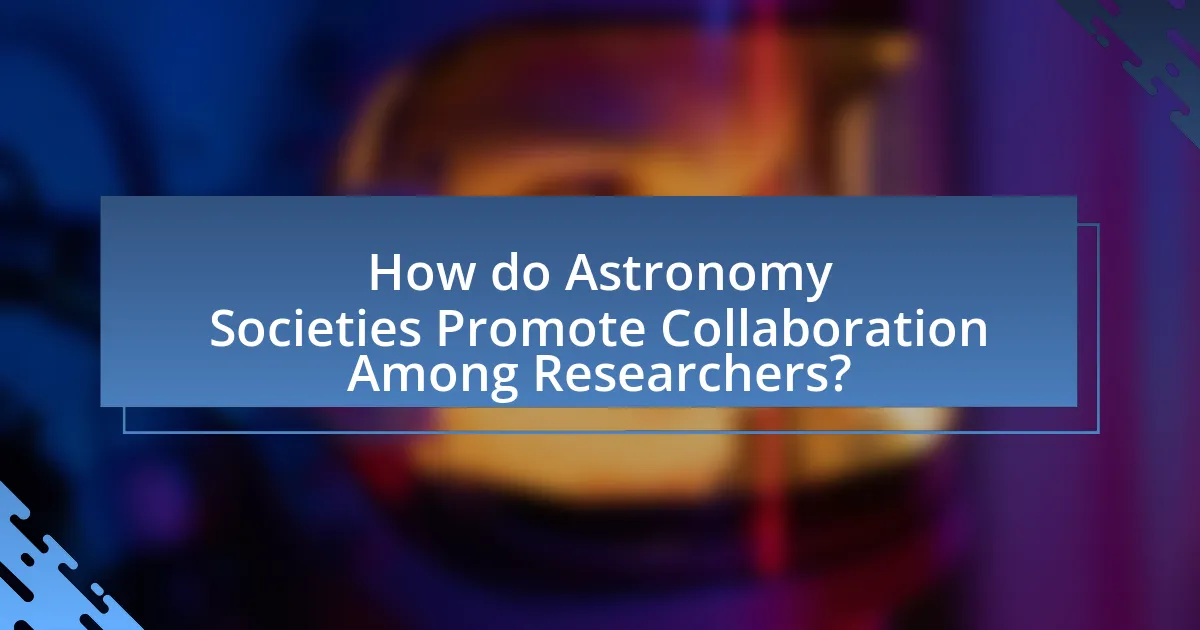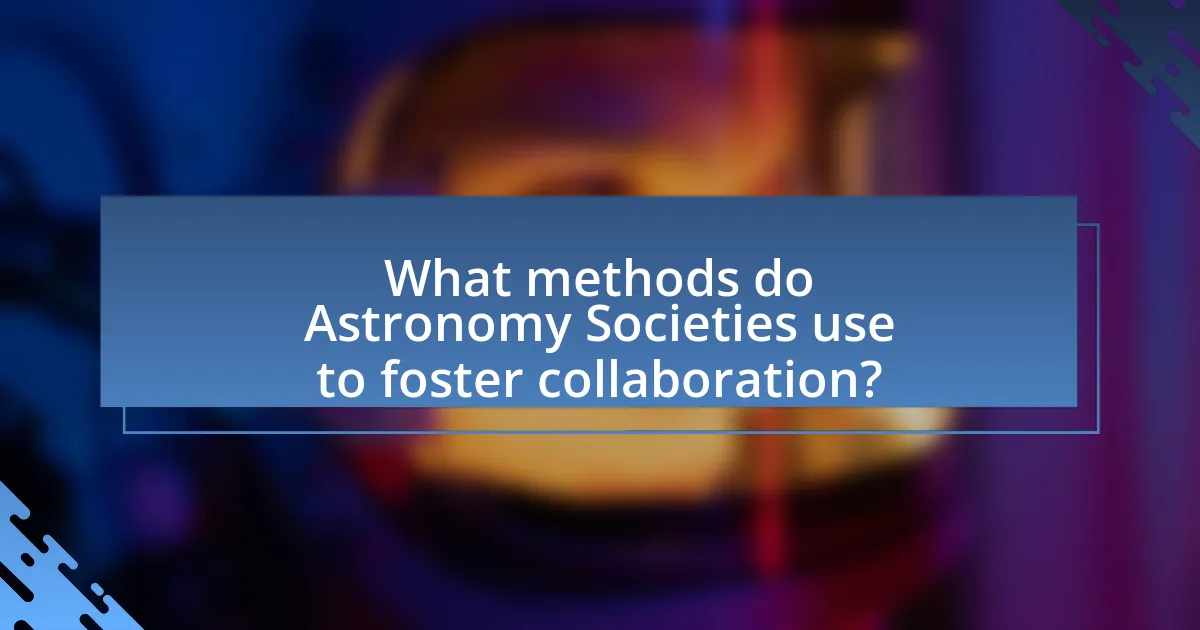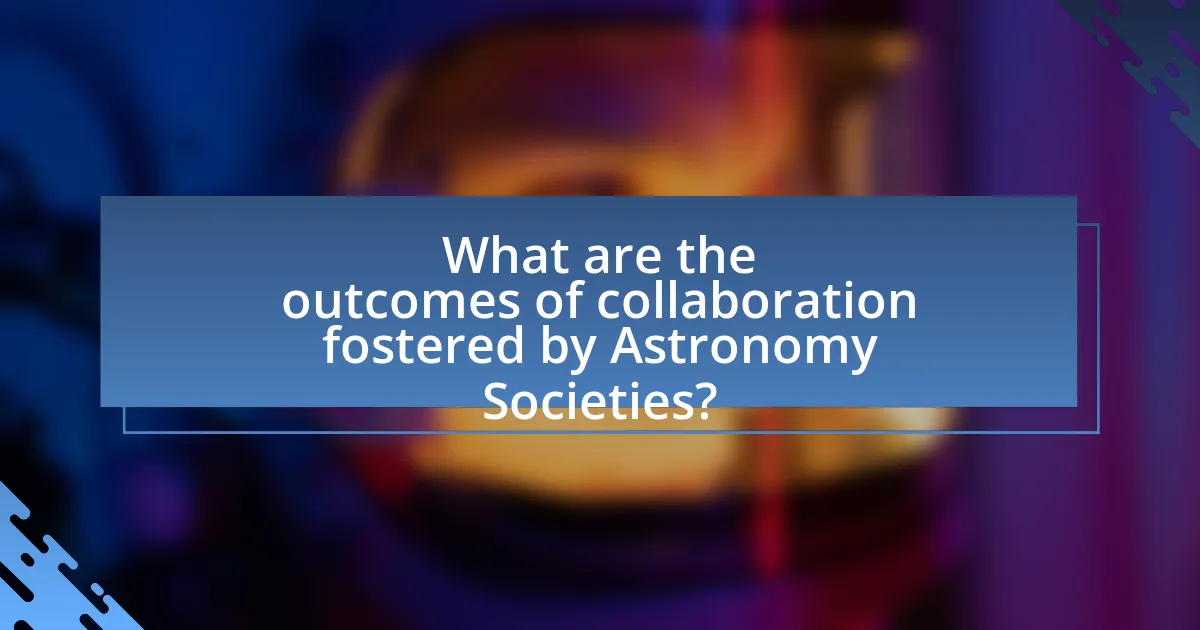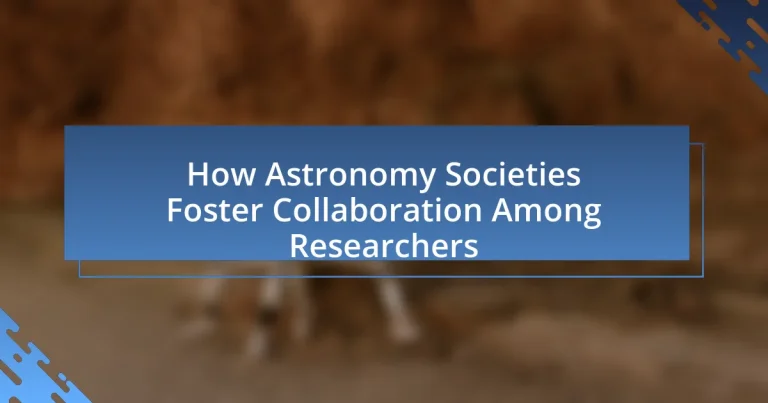Astronomy societies play a crucial role in fostering collaboration among researchers by organizing conferences, workshops, and collaborative projects that enhance knowledge sharing and networking. These societies, such as the American Astronomical Society, facilitate networking opportunities and provide educational resources, thereby promoting interdisciplinary collaboration and accelerating scientific discoveries. The article explores the primary functions of astronomy societies, the importance of collaboration in research, the challenges faced by researchers, and the impact of mentorship and technology on collaborative efforts. Additionally, it highlights notable discoveries resulting from collaborative research and offers best practices for enhancing collaboration among researchers in the field of astronomy.

How do Astronomy Societies Promote Collaboration Among Researchers?
Astronomy societies promote collaboration among researchers by organizing conferences, workshops, and collaborative projects that facilitate knowledge sharing and networking. These events provide platforms for researchers to present their findings, discuss methodologies, and form partnerships, thereby enhancing collective research efforts. For instance, the American Astronomical Society hosts annual meetings that attract thousands of astronomers, fostering an environment where interdisciplinary collaboration can thrive. Additionally, societies often create online forums and collaborative research initiatives, allowing researchers from different institutions to work together on shared goals, which has been shown to accelerate scientific discovery in the field.
What are the primary functions of Astronomy Societies?
The primary functions of Astronomy Societies include promoting astronomical research, facilitating collaboration among researchers, and providing educational resources to the public. These societies organize conferences, workshops, and seminars that encourage networking and the exchange of ideas among astronomers, which enhances collaborative efforts in research. Additionally, they publish journals and newsletters that disseminate findings and advancements in the field, thereby fostering a community of knowledge sharing. For instance, the American Astronomical Society, established in 1899, has played a crucial role in uniting astronomers and advancing the discipline through its various initiatives and publications.
How do Astronomy Societies facilitate networking opportunities?
Astronomy societies facilitate networking opportunities by organizing events such as conferences, workshops, and public lectures that bring together professionals, amateurs, and enthusiasts in the field. These gatherings allow members to share research, discuss advancements, and collaborate on projects, fostering a sense of community. For example, the American Astronomical Society hosts annual meetings that attract thousands of participants, providing a platform for networking and collaboration among researchers. Additionally, societies often maintain online forums and social media groups where members can connect, share resources, and seek advice, further enhancing networking possibilities.
What role do Astronomy Societies play in organizing conferences?
Astronomy societies play a crucial role in organizing conferences by providing a platform for researchers to share their findings and collaborate. These societies facilitate the logistics of conference planning, including venue selection, scheduling, and speaker arrangements, which are essential for successful events. For instance, the American Astronomical Society organizes annual meetings that attract thousands of participants, showcasing the latest research and fostering networking opportunities. This structured approach not only enhances knowledge dissemination but also strengthens professional relationships among astronomers, thereby promoting collaborative research efforts.
Why is collaboration important in the field of astronomy?
Collaboration is important in the field of astronomy because it enables the pooling of diverse expertise and resources, which enhances research capabilities and accelerates discoveries. For instance, large-scale projects like the Event Horizon Telescope, which captured the first image of a black hole, involved over 200 researchers from multiple institutions worldwide, demonstrating how collaborative efforts can lead to groundbreaking results. Additionally, collaboration facilitates data sharing and access to advanced technologies, allowing astronomers to tackle complex problems that would be difficult to address individually. This collective approach not only fosters innovation but also strengthens the scientific community by building networks of knowledge and support among researchers.
How does collaboration enhance research outcomes?
Collaboration enhances research outcomes by facilitating the sharing of diverse expertise and resources among researchers. When researchers from different backgrounds and disciplines work together, they can combine their unique perspectives, leading to innovative solutions and more comprehensive findings. For instance, a study published in the journal “Nature” found that interdisciplinary collaborations significantly increased the likelihood of high-impact publications, demonstrating that collaborative efforts often yield more robust and influential research results.
What are the challenges faced by researchers in collaborating?
Researchers face several challenges in collaborating, including communication barriers, differing institutional priorities, and varying levels of expertise. Communication barriers arise from differences in terminology and language, which can hinder effective information exchange. Differing institutional priorities may lead to conflicts in resource allocation and project focus, making it difficult to align goals. Additionally, varying levels of expertise among collaborators can create imbalances in contribution and understanding, potentially leading to frustration and inefficiency. These challenges are well-documented in studies on collaborative research dynamics, highlighting the need for structured communication and clear role definitions to enhance collaboration effectiveness.

What methods do Astronomy Societies use to foster collaboration?
Astronomy societies foster collaboration through organized events, shared resources, and networking opportunities. These societies host conferences, workshops, and public outreach programs that bring together astronomers, researchers, and enthusiasts to share knowledge and ideas. For instance, the American Astronomical Society organizes annual meetings that attract thousands of participants, facilitating discussions on recent discoveries and collaborative projects. Additionally, societies often provide access to telescopes, databases, and research grants, enabling members to work together on scientific inquiries. This collaborative environment is further enhanced by online platforms and forums where members can communicate and collaborate on research initiatives, thus promoting a culture of teamwork and shared learning within the astronomical community.
How do mentorship programs contribute to collaborative efforts?
Mentorship programs enhance collaborative efforts by fostering relationships that encourage knowledge sharing and skill development among participants. These programs create a structured environment where experienced individuals guide less experienced members, facilitating open communication and collaboration on projects. Research indicates that mentorship leads to increased engagement and productivity, as evidenced by a study published in the Journal of Applied Psychology, which found that mentees often report higher levels of job satisfaction and commitment to their organizations. This dynamic not only strengthens individual capabilities but also cultivates a culture of collaboration within organizations, particularly in fields like astronomy, where teamwork is essential for research success.
What are the benefits of mentorship in astronomy research?
Mentorship in astronomy research provides critical guidance, knowledge transfer, and networking opportunities that enhance the development of emerging scientists. Experienced mentors help mentees navigate complex research challenges, refine their skills, and foster innovative thinking, which is essential in a rapidly evolving field like astronomy. Studies indicate that mentorship significantly improves career outcomes; for instance, a survey by the American Astronomical Society found that mentees are more likely to publish papers and secure funding compared to those without mentorship. This structured support not only accelerates individual growth but also strengthens the overall research community by promoting collaboration and knowledge sharing among researchers.
How can mentorship programs be improved for better collaboration?
Mentorship programs can be improved for better collaboration by implementing structured goals and regular feedback mechanisms. Establishing clear objectives ensures that both mentors and mentees understand their roles and expectations, fostering a more focused partnership. Regular feedback sessions allow participants to assess progress and make necessary adjustments, enhancing the overall effectiveness of the mentorship. Research indicates that structured mentorship programs, such as those outlined in the “Mentoring in STEM: A Review of the Literature” by Crisp and Cruz, show improved outcomes in collaboration and professional development.
What role does technology play in facilitating collaboration?
Technology plays a crucial role in facilitating collaboration by providing tools and platforms that enable seamless communication and data sharing among researchers. For instance, cloud-based platforms allow astronomers to store and access large datasets from anywhere, fostering real-time collaboration on research projects. Additionally, video conferencing tools enable virtual meetings, making it easier for teams to discuss findings and strategies regardless of geographical barriers. According to a study published in the journal “Nature Astronomy,” 85% of researchers reported that technology significantly improved their ability to collaborate effectively. This demonstrates that technology not only enhances communication but also accelerates the pace of research and innovation in the field of astronomy.
How do online platforms enhance communication among researchers?
Online platforms enhance communication among researchers by providing accessible channels for collaboration, information sharing, and networking. These platforms, such as research databases, social media groups, and collaborative tools, facilitate real-time discussions and the exchange of ideas, which is crucial in fields like astronomy where timely data and insights can significantly impact research outcomes. For instance, platforms like ResearchGate and Academia.edu allow researchers to share publications and engage in discussions, leading to increased visibility and collaboration opportunities. Additionally, online forums and webinars hosted by astronomy societies enable researchers to connect across geographical boundaries, fostering a global research community.
What tools are commonly used for collaborative research in astronomy?
Commonly used tools for collaborative research in astronomy include data repositories, collaborative software platforms, and communication tools. Data repositories like the NASA/IPAC Infrared Science Archive and the Sloan Digital Sky Survey provide access to vast datasets that researchers can analyze together. Collaborative software platforms such as GitHub and Overleaf facilitate joint coding and document preparation, allowing multiple authors to contribute simultaneously. Communication tools like Slack and Zoom enable real-time discussions and meetings among researchers, enhancing collaboration across different locations. These tools collectively support the sharing of knowledge and resources, which is essential for advancing astronomical research.

What are the outcomes of collaboration fostered by Astronomy Societies?
Collaboration fostered by Astronomy Societies leads to enhanced research productivity, increased public engagement, and the development of innovative educational programs. These societies facilitate networking among astronomers, which results in joint research projects and shared resources, ultimately accelerating scientific discoveries. For instance, the American Astronomical Society (AAS) organizes meetings that bring together thousands of researchers, leading to collaborations that have produced significant findings in astrophysics. Additionally, Astronomy Societies often engage in outreach activities that promote science literacy, exemplified by programs like the International Year of Astronomy, which reached millions globally. These outcomes demonstrate the vital role that collaboration plays in advancing both scientific knowledge and public interest in astronomy.
How does collaboration lead to innovative research findings?
Collaboration leads to innovative research findings by combining diverse expertise and perspectives, which enhances problem-solving capabilities. When researchers from different fields or backgrounds work together, they can approach challenges from multiple angles, leading to novel solutions and insights. For instance, interdisciplinary collaborations in astronomy have resulted in breakthroughs such as the detection of gravitational waves, where physicists, astronomers, and engineers united their knowledge to develop advanced detection technologies. This synergy not only accelerates the pace of discovery but also fosters creativity, as team members inspire each other to think outside traditional boundaries, ultimately driving innovation in research outcomes.
What are some notable discoveries resulting from collaborative efforts?
Notable discoveries resulting from collaborative efforts in astronomy include the detection of gravitational waves by the LIGO collaboration in 2015, which confirmed a key prediction of Einstein’s general relativity. This groundbreaking achievement involved over 1,000 scientists from multiple institutions worldwide, showcasing the power of teamwork in advancing scientific knowledge. Another significant discovery is the Event Horizon Telescope’s imaging of the black hole in the galaxy M87 in 2019, a project that united researchers across various countries and institutions, demonstrating the effectiveness of collaborative research in tackling complex astronomical challenges.
How can collaborative research impact public understanding of astronomy?
Collaborative research can significantly enhance public understanding of astronomy by integrating diverse expertise and perspectives, which leads to more comprehensive educational outreach. When researchers from various institutions and disciplines work together, they can produce more engaging and accessible content, such as public lectures, interactive exhibits, and educational materials that resonate with a broader audience. For instance, the International Astronomical Union’s efforts in collaborative projects have resulted in initiatives like the “Astronomy for Development” program, which aims to use astronomy as a tool for education and capacity building in developing countries. This collaboration not only disseminates knowledge but also fosters a sense of community and shared interest in astronomical discoveries, ultimately enriching public engagement and understanding of the universe.
What best practices can enhance collaboration among researchers?
Effective communication is a best practice that can significantly enhance collaboration among researchers. Clear and open communication fosters understanding and alignment on research goals, methodologies, and expectations. For instance, regular meetings and updates can help ensure that all team members are informed and engaged, which is supported by studies showing that teams with frequent communication report higher satisfaction and productivity. Additionally, utilizing collaborative tools such as shared online platforms for data and document management can streamline workflows and facilitate real-time collaboration, as evidenced by the increased efficiency reported in research projects that adopt such technologies.
How can researchers effectively engage with Astronomy Societies?
Researchers can effectively engage with Astronomy Societies by actively participating in society events, contributing to discussions, and collaborating on projects. Engaging in events such as conferences, workshops, and public outreach programs allows researchers to network with fellow astronomers and share their findings. Additionally, contributing articles or presentations to society publications fosters a sense of community and collaboration. Research indicates that societies like the American Astronomical Society facilitate partnerships that enhance research visibility and funding opportunities, demonstrating the value of active participation in these organizations.
What strategies can be employed to overcome collaboration barriers?
To overcome collaboration barriers, astronomy societies can implement strategies such as establishing clear communication channels, fostering a culture of inclusivity, and utilizing collaborative technologies. Clear communication channels, such as regular meetings and dedicated online platforms, ensure that all members are informed and engaged, reducing misunderstandings. Fostering a culture of inclusivity encourages diverse perspectives, which enhances problem-solving and innovation. Utilizing collaborative technologies, like shared databases and project management tools, streamlines workflows and facilitates real-time collaboration among researchers. These strategies have been shown to improve teamwork and project outcomes in various scientific fields, including astronomy, where collaboration is essential for advancing research.


